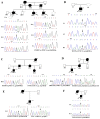Identification of a novel hypertrophic cardiomyopathy-associated mutation using targeted next-generation sequencing
- PMID: 28498465
- PMCID: PMC5466385
- DOI: 10.3892/ijmm.2017.2986
Identification of a novel hypertrophic cardiomyopathy-associated mutation using targeted next-generation sequencing
Abstract
Hypertrophic cardiomyopathy (HCM), one of the most common forms of myocardial diseases, is the major cause of sudden cardiac death in young adults and competitive athletes. Analyses of gene mutations associated with HCM are valuable for its molecular diagnosis, genetic counseling, and management of familial HCM. To dissect the relationship between the clinical presentation and gene mutations of HCM, the genetic characterizations of 19 HCM-related genes in 18 patients (8 cases from 6 pedigrees with familial HCM and 10 cases without familial HCM) were detected using next-generation sequencing (NGS). As a result, 12 disease-related mutations were identified in the 18 subjects, including 6 single mutations and 3 double mutations [MYBPC3 (p.Gln998Glu) plus TNNI3 (p.Arg145Gly), PRKAG2 (p.Gly100Ser) plus MYBPC3 (p.Lys1209Serfs*28) and TNNI3 (p.Glu124Gln) plus GLA (p.Trp47*)]. The 3 heterozygous double mutations were discovered for the first time in the malignant familial HCM patients. Of the 6 single mutations, a novel mutation was found in tafazzin (TAZ, p.Ile208Val), and a mutation in β-myosin heavy chain gene (MYH7, p.Arg54Gln), which was reported as rare in the general population, was firstly found in one HCM patient. Identification of novel and rare mutations in HCM patients have added new data to the spectrum of gene mutations associated with this disease. These findings provide an essential basis for the molecular diagnosis and better management of family members at risk of familial HCM.
Figures






Similar articles
-
Identification of novel mutations including a double mutation in patients with inherited cardiomyopathy by a targeted sequencing approach using the Ion Torrent PGM system.Int J Mol Med. 2016 Jun;37(6):1511-20. doi: 10.3892/ijmm.2016.2565. Epub 2016 Apr 14. Int J Mol Med. 2016. PMID: 27082122 Free PMC article.
-
MYH7 Gene-Related Mutation p.V878L Identified in a Chinese Family with Hypertrophic Cardiomyopathy.Int Heart J. 2019 Nov 30;60(6):1415-1420. doi: 10.1536/ihj.19-146. Epub 2019 Nov 15. Int Heart J. 2019. PMID: 31735781
-
Genetic screening and double mutation in Japanese patients with hypertrophic cardiomyopathy.Circ J. 2011;75(11):2654-9. doi: 10.1253/circj.cj-10-1314. Epub 2011 Jul 29. Circ J. 2011. PMID: 21799269 Clinical Trial.
-
[Familial hypertrophic cardiomyopathy: genes, mutations and animal models. A review].Invest Clin. 2004 Mar;45(1):69-99. Invest Clin. 2004. PMID: 15058760 Review. Spanish.
-
Genetics of hypertrophic cardiomyopathy after 20 years: clinical perspectives.J Am Coll Cardiol. 2012 Aug 21;60(8):705-15. doi: 10.1016/j.jacc.2012.02.068. Epub 2012 Jul 11. J Am Coll Cardiol. 2012. PMID: 22796258 Review.
Cited by
-
Multinational experience with next-generation sequencing: opportunity to identify transthyretin cardiac amyloidosis and Fabry disease.Cardiovasc Diagn Ther. 2024 Apr 30;14(2):294-303. doi: 10.21037/cdt-23-191. Epub 2024 Mar 18. Cardiovasc Diagn Ther. 2024. PMID: 38716318 Free PMC article.
-
When Paying Attention Pays Back: Missense Mutation c.1006G>A p. (Val336Ile) in PRKAG2 Gene Causing Left Ventricular Hypertrophy and Conduction Abnormalities in a Caucasian Patient: Case Report and Literature Review.Int J Mol Sci. 2024 Aug 23;25(17):9171. doi: 10.3390/ijms25179171. Int J Mol Sci. 2024. PMID: 39273120 Free PMC article. Review.
-
Heart rate variability as predictive factor for sudden cardiac death.Aging (Albany NY). 2018 Feb 23;10(2):166-177. doi: 10.18632/aging.101386. Aging (Albany NY). 2018. PMID: 29476045 Free PMC article. Review.
-
Clinical Interpretation of Sequence Variants.Curr Protoc Hum Genet. 2020 Jun;106(1):e98. doi: 10.1002/cphg.98. Curr Protoc Hum Genet. 2020. PMID: 32176464 Free PMC article.
-
Novel frameshift variant in MYL2 reveals molecular differences between dominant and recessive forms of hypertrophic cardiomyopathy.PLoS Genet. 2020 May 26;16(5):e1008639. doi: 10.1371/journal.pgen.1008639. eCollection 2020 May. PLoS Genet. 2020. PMID: 32453731 Free PMC article.
References
-
- Ackerman MJ, Priori SG, Willems S, Berul C, Brugada R, Calkins H, Camm AJ, Ellinor PT, Gollob M, Hamilton R, et al. Heart Rhythm Society (HRS) European Heart Rhythm Association (EHRA) HRS/EHRA expert consensus statement on the state of genetic testing for the channelopathies and cardiomyopathies: This document was developed as a partnership between the Heart Rhythm Society (HRS) and the European Heart Rhythm Association (EHRA) Europace. 2011;13:1077–1109. doi: 10.1093/europace/eur245. - DOI - PubMed
MeSH terms
Substances
LinkOut - more resources
Full Text Sources
Other Literature Sources
Research Materials

